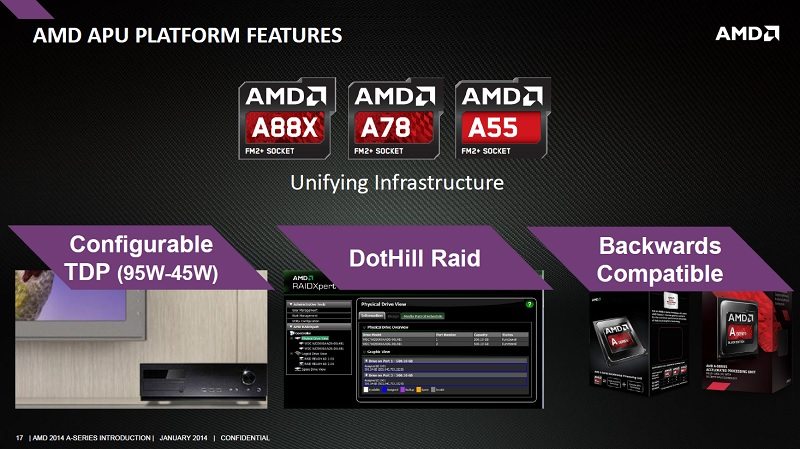AMD Kaveri Review: A10-7850K, A10-7700K and A8-7600
Ryan Martin / 10 years ago
Kaveri’s Features
Let’s start this review off by looking at Kaveri’s fundamentals. At the heart of Kaveri we can see a growing GPU die area that AMD is classifying in a new way. More specifically AMD is designating “compute cores” from the CPU and GPU areas. On the CPU side we have a familiar 4 cores while on the GPU side AMD is classifying a GPU “core” as a block of 64 GCN shaders (but also commonly called cores however we won’t use that to avoid confusion!). Therefore we end up with 8 GPU cores and 4 CPU cores on the flagship part – the A10-7850K – giving a total of 12 compute cores. The two lower spec’d parts, the A10-7700K and A8-7600, both use 4 CPU cores and 6 GPU cores as they have two GPU cores (or 128 GCN shaders) disabled.
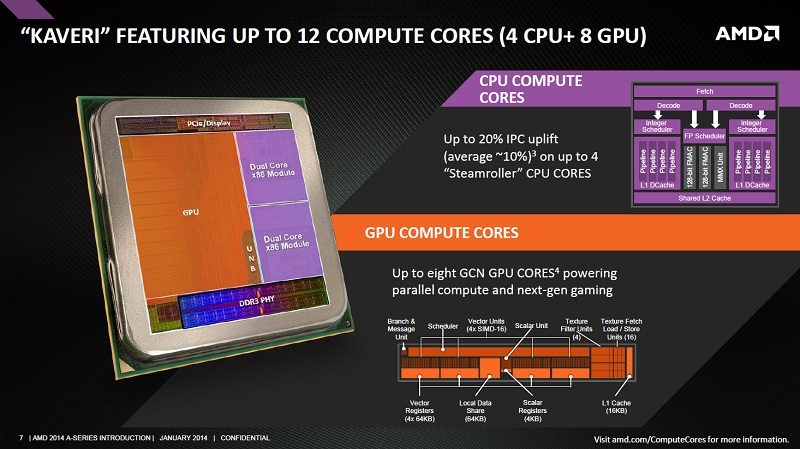
Next on the list of key architectural features is the HSA package. First we have hUMA, or the Heterogeneous Unified Memory Architecture, which is essentially a mechanism for allowing the CPU and GPU to have equal priority access of up to 32GB of system memory. There is uniform visibility for both the CPU and GPU part so neither part will be short-changed in favour of the other. This is important for AMD as the point of the APU is that it isn’t “just” a CPU with graphics stuck on, but a CPU and GPU combination where both parts can work simultaneously and are both as powerful as each other. This feeds nicely onto hQ, which is Heterogeneous Queuing, and this is the mechanism that defines the interaction between the CPU and GPU parts. This allows the CPU and GPU parts equal flexibility in creating and dispatching “work” and allows them to work side by side. Note that while HSA is impressive technology in itself, the idea behind HSA requires an ecosystem to function. That means it requires software developers, game developers, hardware developers and a whole range of key players in the technology industry to work together to allow HSA to actually be used in practice. We are still waiting on other HSA foundation members to respond to AMD’s new HSA product. The HSA foundation includes ARM, MediaTek, Imagination, Qualcomm, Samsung and Texas Instruments so if those technology giants choose to accelerate HSA adoption then there is no reason why it won’t become a widespread standard with significant adoption.
Of course so far I’ve stressed the importance of valuing the GPU as much as the CPU but from AMD’s perspective it really is all about the GPU these days. The impression I’ve attained so far from AMD and Kaveri is that the CPU is adequate for allowing the GPU to shine but the CPU isn’t where AMD’s focus is. AMD’s focus is in allowing the GPU to be utilised more by offloading tasks away from the CPU that can be more efficiently processed by the GPU to make the CPU less important over time. I totally understand AMD’s perspective because today most modern x86 CPUs are already more powerful than we need for most things, even if we look at the so called “budget” or “low end” CPUs like Intel’s Haswell Pentiums or AMD’s Richland Athlons. The GPU is where the biggest performance gains can be had. The revised focus, from AMD’s perspective, is on improving the performance of the GPU and moving the whole PC ecosystem to an ecosystem where GPU acceleration is the norm. As far as the CPU goes; improving IPC while reducing power consumption is the main aim.
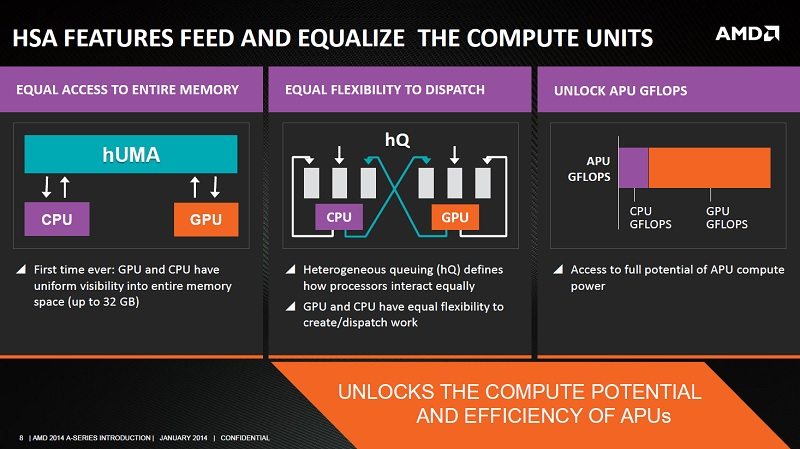
AMD’s Kaveri will have hardware level support for AMD’s new TrueAudio technology. Like the HSA technologies the TrueAudio technology is another technology from AMD which has the potential to revolutionise its speciality, audio, but it requires that software developers use the technology when developing. TrueAudio is excellent in theory offering more audio channels, better directional audio and reduced system resource usage from audio processing, but it requires AMD to get software and game developers on-board for the hardware to be able to bring benefits to consumers. If uptake is as slow as that of Open CL and Open GL (for example) then we will certainly not see any immediate benefits from TrueAudio, but the potential is huge. I think the key issue with a lot of these AMD technologies is how to make them “mainstream”, if developers can see that these new hardware technologies are limited to AMD products only then the incentive to develop for them is minimal. This is because in the CPU market Intel has the dominant market share while in the GPU market Intel and Nvidia both have larger shares than AMD.
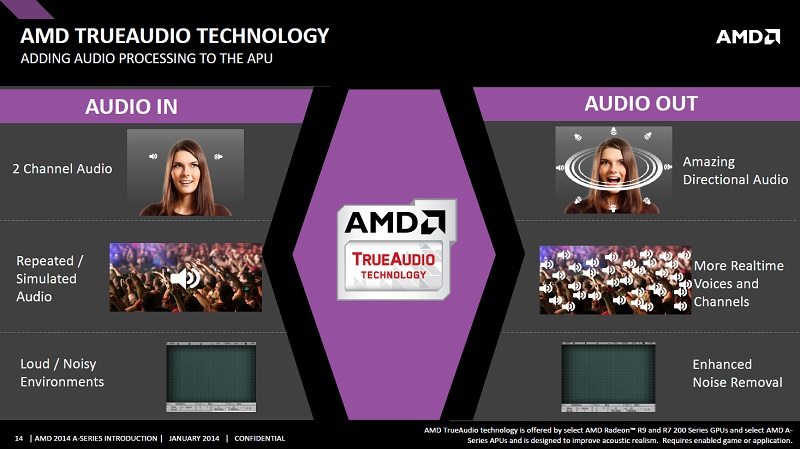
Given the dependence on system memory for both the GPU and CPU, AMD’s Kaveri APUs shows significant scaling with rising memory speeds. The difference between 1600 and 2400MHz frequencies during in-game performance is as much as 40% frame rate scaling so to benefit from Kaveri 1866MHz memory or higher is a must, though 2133MHz memory is ideal. Given the falling price of high speed DRAM products kits with those higher frequencies are more affordable than ever. For example in the USA an 8GB 2133MHz kit holds just a $15 premium over an 8GB 1600MHz kit yet has the potential to boost GPU performance by as much as 30%.
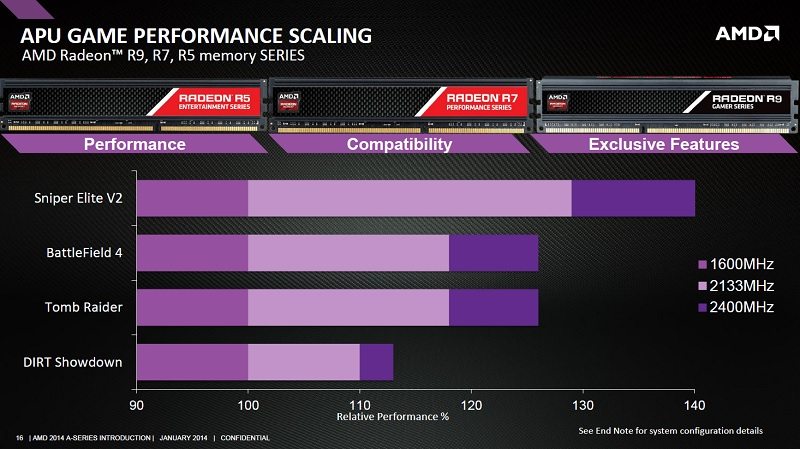
Other features of the AMD Kaveri platform include the hugely exciting configurable TDP option. This is mainly optimised for the A8-7600 but it will work on all Kaveri APUs. You can basically specify a TDP anywhere between 45 and 95W to tame the power consumption and thermal output of your APU. Additionally, all Kaveri APUs are backwards compatible with FM2+ motherboards on the A88X, A78 and A55 chipsets. As a result of the chipset support, AMD also continue to offer extensive RAID support making AMD motherboards the ideal solution for affordable NAS systems, as our upcoming DIY NAS build will hope to demonstrate. Please do stay tuned for that as it’s coming very soon!
